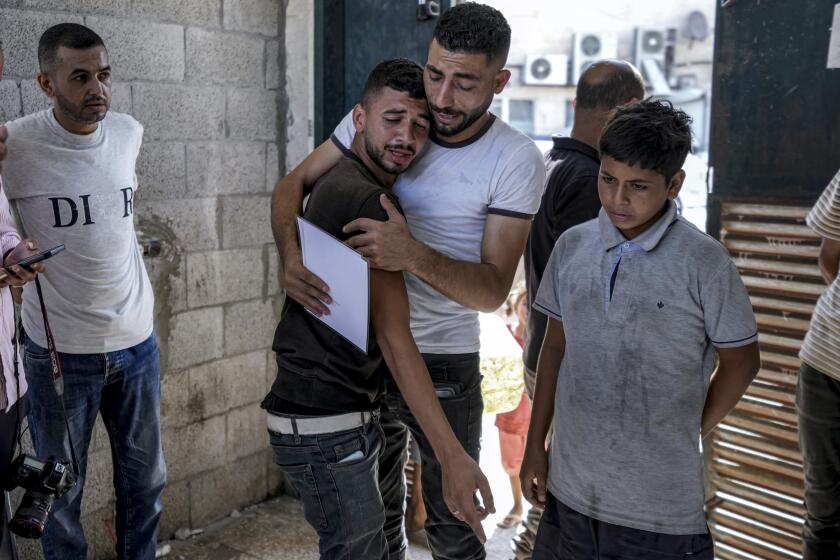Israel recovers bodies of 6 hostages from Gaza; Blinken leaves Mideast without cease-fire deal

JERUSALEM — The Israeli military said Tuesday that it recovered the bodies of six hostages taken in Hamas’ Oct. 7 attack that started the war in Gaza, as U.S. and Arab mediators failed to advance an agreement to halt the fighting and release scores of other militant-held captives.
The military said its forces recovered the six bodies of hostages in an overnight operation in the southern Gaza Strip, saying they were killed during a time that troops were operating in Khan Yunis. The militant group Hamas says some captives have been killed in Israeli airstrikes. Hostages who have returned to Israel have talked about difficult conditions in captivity, including lack of food or medications.
An Israeli airstrike Tuesday killed at least 12 people at a school-turned-shelter in Gaza City in what the military said was a precision strike on a Hamas command center. Another strike killed a mother and her five children in central Gaza.
The recovery of the hostages’ remains is a blow to Hamas, which hopes to exchange its captives for Palestinian prisoners, an Israeli withdrawal and a lasting cease-fire. But it was also likely to increase pressure on Israel’s government to reach a deal to free dozens more hostages who are still believed to be alive.
The Israeli military said it had identified the remains of Chaim Perry, 80; Yoram Metzger, 80; Avraham Munder, 79; Alexander Dancyg, 76; Nadav Popplewell, 51; and Yagev Buchshtav, 35. Metzger, Munder, Popplewell and Buchshtav had family members who were also abducted but freed during a November cease-fire.
Secretary of State Blinken says Israel accepted a proposal for a Gaza cease-fire and hostage release, but does not say if Hamas concerns were addressed.
Munder’s death was confirmed Tuesday by Kibbutz Nir Oz, the farming community where he was among about 80 residents who were taken captive. It said he died “after enduring months of physical and mental torture.” Israeli authorities previously determined that the other five were deceased.
Israeli Prime Minister Benjamin Netanyahu praised the recovery effort and said “our hearts ache for the terrible loss.”
The news brought fresh grief for many Israelis who have long pressed Netanyahu to agree to a cease-fire that would bring remaining hostages home. New protests were held Tuesday. “The longer they’re there, the more body bags we get,” said one protester, Adi Israeli, in Tel Aviv.
Hamas is still believed to be holding about 110 hostages captured in the Oct. 7 attack. Israeli authorities estimate around a third of them are dead.
U.S. Secretary of State Antony J. Blinken ended his visit to the Middle East — his ninth since the start of the war in Gaza — without securing any major breakthrough for a cease-fire deal, warning on Tuesday that “time is of the essence” even as Israel and Hamas signaled that challenges remain.
After meetings in fellow mediating countries Egypt and Qatar, Blinken said that because Israel has accepted a U.S. proposal to bridge gaps with the militant group, the focus turns to doing everything possible to “get Hamas on board” and ensure both sides agree to key details on implementation.
“Our message is simple. It’s clear and it’s urgent,” he told reporters before leaving Qatar. “We need to get a cease-fire and hostage agreement over the finish line, and we need to do it now. Time is of the essence.”
There has been added urgency to seal a deal after the recent killings of militant leaders of Hamas and Hezbollah in Iran and Lebanon, both blamed on Israel, and vows of retaliation that have sparked fears of a wider regional war.
Few details have been released about the so-called bridging proposal put forth by the U.S., Egypt and Qatar. Blinken said it is “very clear on the schedule and the locations of [Israeli military] withdrawals from Gaza.”
Hamas called the latest proposal presented to it a “reversal” of what it had agreed to, and accused the United States in a statement of acquiescing to new conditions from Israel. There was no immediate U.S. response.
Blinken’s comments on ending his latest Israel-Hamas peace mission were notably bare of the optimism that Biden administration officials expressed going into his trip, and even before that.
The upbeat tone through much of the spring and summer — with U.S. officials at times describing a cease-fire and hostage deal as nearer than ever — reflected necessary messaging, at least in part, said Jonathan Panikoff, director of the Scowcroft Middle East Security Initiative at the Atlantic Council’s Middle East Program.
“If they don’t project optimism then it won’t create ... even the potential for sufficient momentum to keep things going,” Panikoff said.
Americans have little alternative to continuing to push Israel and Hamas to agree to a negotiated end to fighting, but it’s fundamentally about Netanyahu and new Hamas leader Yahya Sinwar, who helped mastermind the Oct. 7 attack, Panikoff said. And they are “the two people that have been, frankly, most skeptical from the beginning” about making peace.
Netanyahu, meanwhile, met with right-wing groups of families of fallen soldiers and hostages that oppose a cease-fire deal.
Blinken’s meetings in Egypt, which borders Gaza, and in Qatar, which hosts some Hamas leaders in exile, came a day after he met Netanyahu. Wide gaps appeared to remain between Israel and Hamas, though angry statements often serve as pressure tactics during negotiations.
Hamas-led militants burst through Israel’s defenses on Oct. 7 and attacked across the south, killing some 1,200 people, mostly civilians, and taking around 250 hostage. More than 100 hostages were released in exchange for Palestinians imprisoned in Israel during the weeklong cease-fire in the fall.
Israel’s retaliatory offensive has killed more than 40,000 Palestinians, according to Gaza’s Health Ministry, whose numbers do not differentiate between civilians and combatants. Air and ground operations have caused widespread destruction and forced the vast majority of Gaza’s 2.3 million residents to flee their homes, often multiple times. Aid groups fear the outbreak of diseases including polio.
Mohammad Abu Al-Qumsan lost his children, wife, and mother-in-law in an Israeli strike that hit a Gaza Strip apartment building while he was away.
In Tuesday’s Israeli airstrike that killed 12 in Gaza City, the Palestinian Civil Defense, first responders operating under the Hamas-run government, said about 700 people were sheltering at the Mustafa Hafez school. Israel’s military said the strike targeted Hamas militants who had set up a command center inside the school.
“We don’t know where to go … or where to shelter our children,” said Umm Khalil abu Agwa, a displaced woman there.
An Israeli airstrike in Deir al Balah hit people walking down the street and seven were killed, including a woman and two children, according to an Associated Press journalist who counted the bodies. More than 20 other people were wounded. Another airstrike in central Gaza killed five children and their mother, according to Al Aqsa Martyrs Hospital, where an AP journalist counted the bodies.
Palestinians displaced by recent Israeli evacuation orders crowded into already teeming areas. One child in Deir al Balah slept on cardboard as insects flew around his face.
“Are they going to dig the ground and dump us there, or put us on a boat and throw us in the sea? I don’t know,” said one man, Abu Shady Afana.
Frankel writes for the Associated Press. AP reporters Wafaa Shurafa in Deir al Balah, Samy Magdy in Cairo and Matthew Lee in El Alamein, Egypt, contributed to this report.
More to Read
Sign up for Essential California
The most important California stories and recommendations in your inbox every morning.
You may occasionally receive promotional content from the Los Angeles Times.












